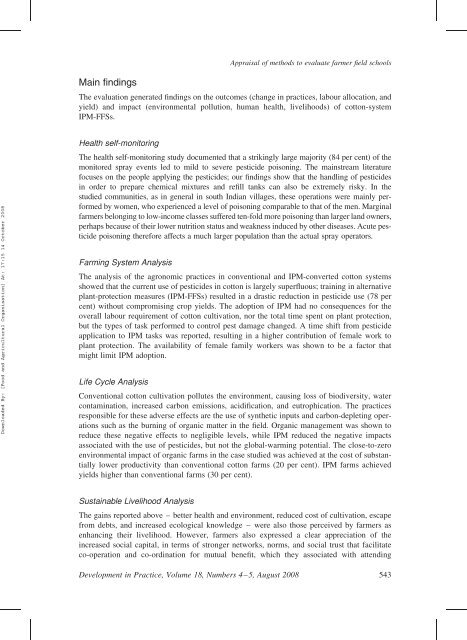Main findings<strong>Appraisal</strong> <strong>of</strong> <strong>methods</strong> <strong>to</strong> <strong>evaluate</strong> <strong>farmer</strong> <strong>field</strong> <strong>schools</strong>The evaluation generated findings on the outcomes (change in practices, labour allocation, andyield) and impact (environmental pollution, human health, livelihoods) <strong>of</strong> cot<strong>to</strong>n-systemIPM-FFSs.Downloaded By: [Food and Agricultural Organisation] At: 17:15 14 Oc<strong>to</strong>ber 2008Health self-moni<strong>to</strong>ringThe health self-moni<strong>to</strong>ring study documented that a strikingly large majority (84 per cent) <strong>of</strong> themoni<strong>to</strong>red spray events led <strong>to</strong> mild <strong>to</strong> severe pesticide poisoning. The mainstream literaturefocuses on the people applying the pesticides; our findings show that the handling <strong>of</strong> pesticidesin order <strong>to</strong> prepare chemical mixtures and refill tanks can also be extremely risky. In thestudied communities, as in general in south Indian villages, these operations were mainly performedby women, who experienced a level <strong>of</strong> poisoning comparable <strong>to</strong> that <strong>of</strong> the men. Marginal<strong>farmer</strong>s belonging <strong>to</strong> low-income classes suffered ten-fold more poisoning than larger land owners,perhaps because <strong>of</strong> their lower nutrition status and weakness induced by other diseases. Acute pesticidepoisoning therefore affects a much larger population than the actual spray opera<strong>to</strong>rs.Farming System AnalysisThe analysis <strong>of</strong> the agronomic practices in conventional and IPM-converted cot<strong>to</strong>n systemsshowed that the current use <strong>of</strong> pesticides in cot<strong>to</strong>n is largely superfluous; training in alternativeplant-protection measures (IPM-FFSs) resulted in a drastic reduction in pesticide use (78 percent) without compromising crop yields. The adoption <strong>of</strong> IPM had no consequences for theoverall labour requirement <strong>of</strong> cot<strong>to</strong>n cultivation, nor the <strong>to</strong>tal time spent on plant protection,but the types <strong>of</strong> task performed <strong>to</strong> control pest damage changed. A time shift from pesticideapplication <strong>to</strong> IPM tasks was reported, resulting in a higher contribution <strong>of</strong> female work <strong>to</strong>plant protection. The availability <strong>of</strong> female family workers was shown <strong>to</strong> be a fac<strong>to</strong>r thatmight limit IPM adoption.Life Cycle AnalysisConventional cot<strong>to</strong>n cultivation pollutes the environment, causing loss <strong>of</strong> biodiversity, watercontamination, increased carbon emissions, acidification, and eutrophication. The practicesresponsible for these adverse effects are the use <strong>of</strong> synthetic inputs and carbon-depleting operationssuch as the burning <strong>of</strong> organic matter in the <strong>field</strong>. Organic management was shown <strong>to</strong>reduce these negative effects <strong>to</strong> negligible levels, while IPM reduced the negative impactsassociated with the use <strong>of</strong> pesticides, but not the global-warming potential. The close-<strong>to</strong>-zeroenvironmental impact <strong>of</strong> organic farms in the case studied was achieved at the cost <strong>of</strong> substantiallylower productivity than conventional cot<strong>to</strong>n farms (20 per cent). IPM farms achievedyields higher than conventional farms (30 per cent).Sustainable Livelihood AnalysisThe gains reported above – better health and environment, reduced cost <strong>of</strong> cultivation, escapefrom debts, and increased ecological knowledge – were also those perceived by <strong>farmer</strong>s asenhancing their livelihood. However, <strong>farmer</strong>s also expressed a clear appreciation <strong>of</strong> theincreased social capital, in terms <strong>of</strong> stronger networks, norms, and social trust that facilitateco-operation and co-ordination for mutual benefit, which they associated with attendingDevelopment in Practice, Volume 18, Numbers 4–5, August 2008 543
Francesca Mancini and Janice JigginsIPM-FFSs, which was perceived as a resource <strong>to</strong> achieve better development and control overtheir own destinies. Specifically, the social benefits were described in terms <strong>of</strong> increased collaborationbetween villagers and stronger connections with agricultural <strong>of</strong>ficers and village authorities.Collective action in the Indian rural society studied takes place typically in informalnetworks, rather than in the <strong>of</strong>ficial groups registered <strong>to</strong> receive the financial incentivesgiven by the government. It has been shown elsewhere that communities with higher collectiveaction are more inclined <strong>to</strong> act for mutual benefits (Krishna 2003). The evaluation study alsorevealed that the process <strong>of</strong> personal growth stimulated by participation in the IPM-FFSswas particularly relevant <strong>to</strong> women, and it confirms the importance <strong>of</strong> increasing women’saccess <strong>to</strong> educational programmes.Downloaded By: [Food and Agricultural Organisation] At: 17:15 14 Oc<strong>to</strong>ber 2008Pho<strong>to</strong> visioningThe pictures taken were grouped by the <strong>farmer</strong>s in pho<strong>to</strong>-visioning workshops, at which thepho<strong>to</strong>graphs were analysed in<strong>to</strong> clusters, connected by causal or explana<strong>to</strong>ry linkages. Thisprocess generated new insights in<strong>to</strong> the occurrence <strong>of</strong> and the relations between unpredictedimpacts, such as improvements in animal health and production, as well as in non-targetcrop management.Methodological appraisal <strong>of</strong> the evaluationSome study components aimed <strong>to</strong> provide in-depth information concerning a selected aspect <strong>of</strong>the evaluation and therefore used <strong>methods</strong> selected <strong>to</strong> describe the behaviour <strong>of</strong> a small group <strong>of</strong><strong>farmer</strong>s/farms – the health moni<strong>to</strong>ring, and the pho<strong>to</strong> visioning. Findings obtained throughthese descriptive <strong>methods</strong> can be extrapolated with caution <strong>to</strong> a larger population who mightbe considered similar (but for whom there is no direct evidence). The Farming System Analysis,the LCA, and the SLA on the other hand aimed <strong>to</strong> explain the behaviour <strong>of</strong> a representativegroup <strong>of</strong> the <strong>to</strong>tal population and <strong>to</strong> allow for generalisation <strong>of</strong> the findings. Given the differentinformational objectives <strong>of</strong> the <strong>methods</strong> <strong>of</strong> enquiry used, we now turn <strong>to</strong> assessing the degree <strong>of</strong>participation, data validity and accuracy, and other strengths and weaknesses <strong>of</strong> each method.The participa<strong>to</strong>ry <strong>methods</strong> are also <strong>evaluate</strong>d in terms <strong>of</strong> their educational value, empowerment,and contribution <strong>to</strong> gender analysis.Defining the degree <strong>of</strong> participation in the <strong>methods</strong> usedThe extent <strong>to</strong> which each method used in this evaluation was participa<strong>to</strong>ry is defined hereaccording <strong>to</strong> the four criteria described by Lawrenz and Huffman (2003): (1) type <strong>of</strong> evaluationinformation collected, such as defining questions and instruments; (2) participation in the evaluationprocess; (3) decisions concerning the data <strong>to</strong> provide; and (4) use <strong>of</strong> evaluation information.‘Outsider’ evalua<strong>to</strong>rs defined the study objectives and selected the research <strong>to</strong>ols in each case.Farmers’ involvement in the decision making pertaining <strong>to</strong> the four steps <strong>of</strong> the methodologyis outlined in Table 2. The LCA and Farming System Analysis represent the non-participativeend <strong>of</strong> the spectrum, being based on questionnaires developed from the reference literature andpreliminary diagnostic studies in the <strong>field</strong>, and leading <strong>to</strong> findings that were difficult <strong>to</strong> sharedirectly with the local communities. The health-moni<strong>to</strong>ring study had a primary researchfocus; however, it also had the additional educational value <strong>of</strong> being built in<strong>to</strong> the FFS curriculumand therefore was coupled with access <strong>to</strong> a viable alternative <strong>to</strong> the use <strong>of</strong> pesticides. In the SLA,<strong>farmer</strong>s defined the meaning <strong>of</strong> the concepts that framed the enquiry, and decided on the type <strong>of</strong>information <strong>to</strong> be collected within the given framework. The closest <strong>to</strong> full participation, or544 Development in Practice, Volume 18, Numbers 4–5, August 2008




![Section 4 [ PDF file, 252 KB] - The Field Alliance](https://img.yumpu.com/51387260/1/158x260/section-4-pdf-file-252-kb-the-field-alliance.jpg?quality=85)











